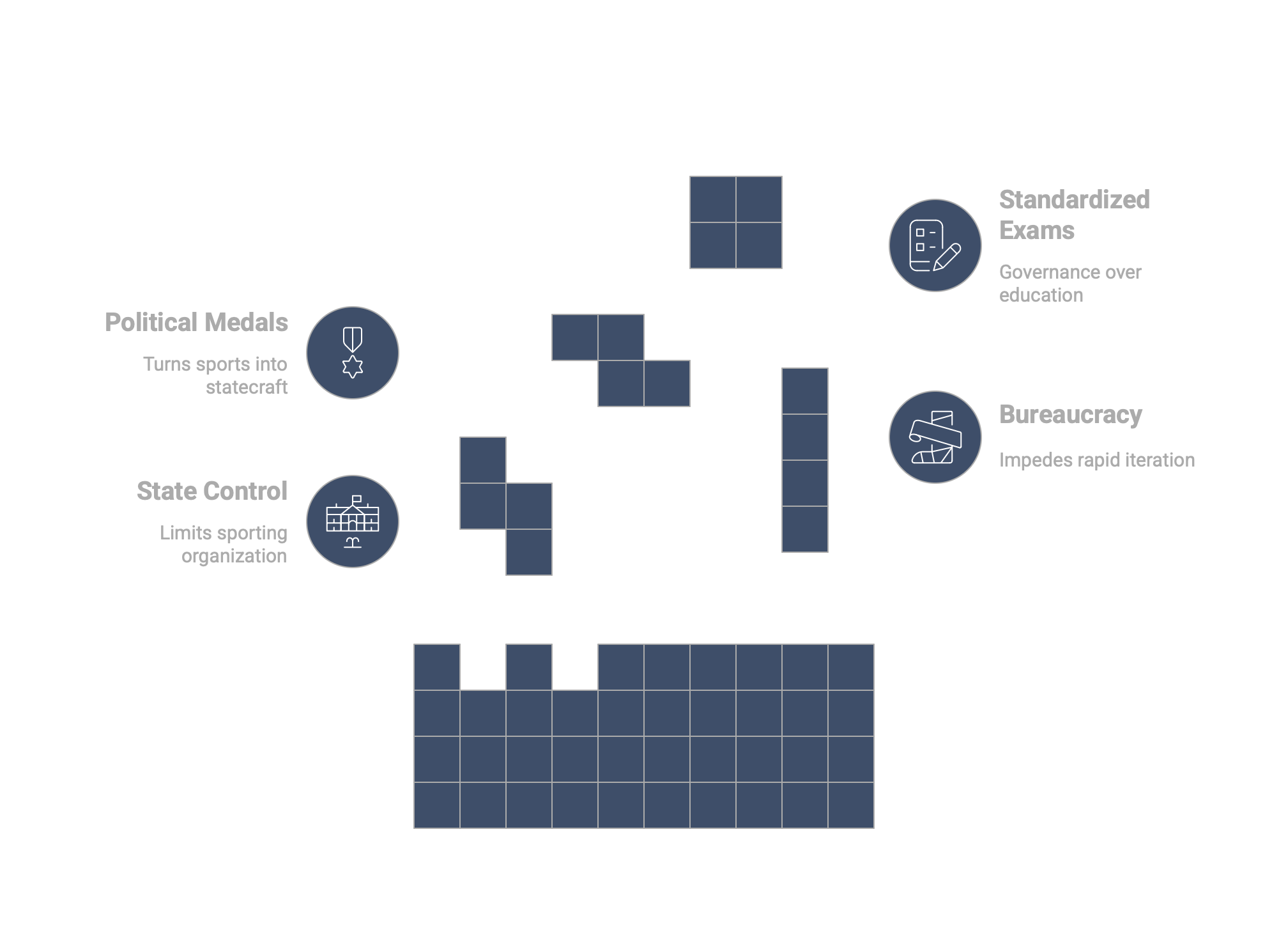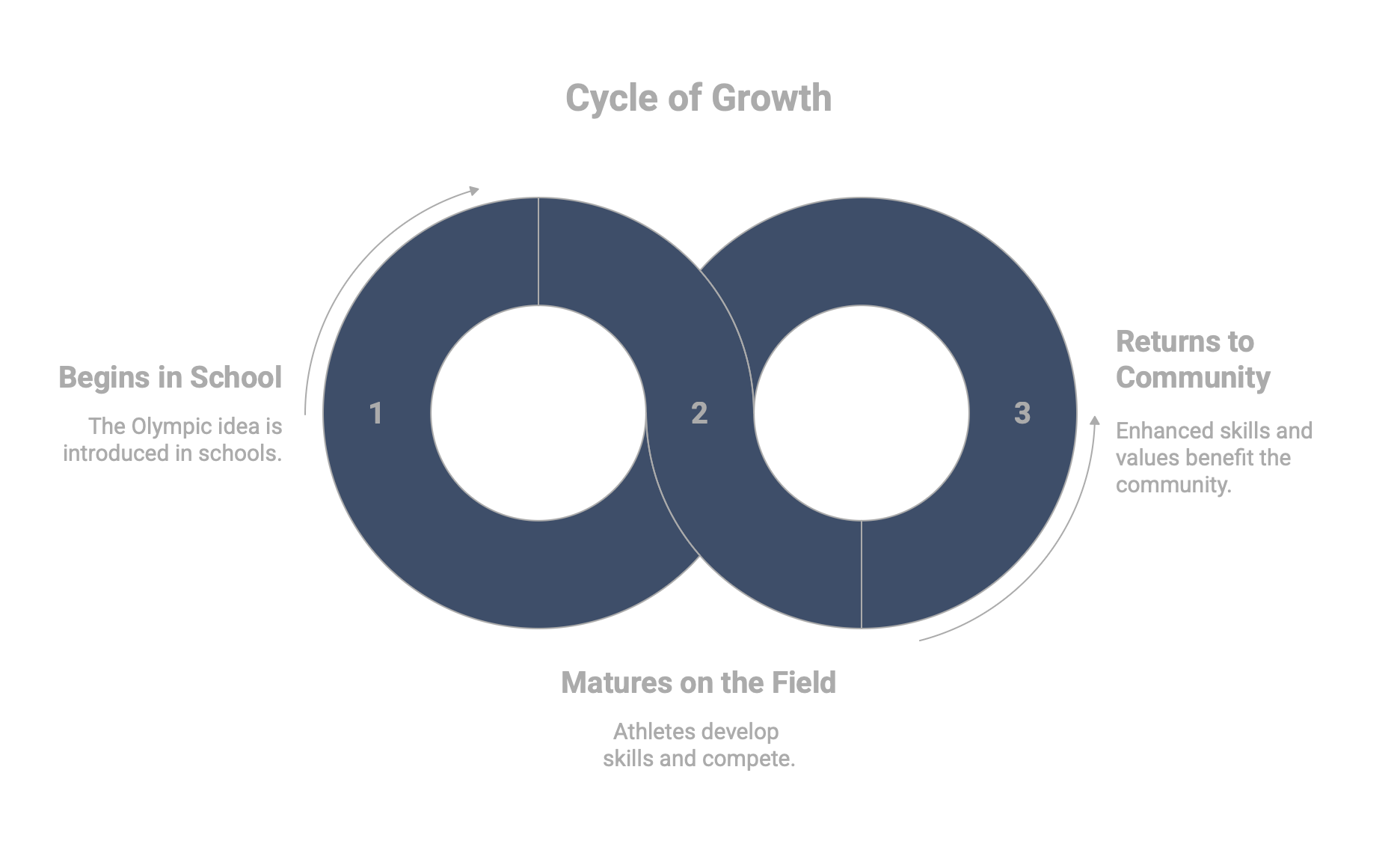Walk into a national training center or National Olympic Committee offices and you’ll see athletes chasing the margins that decide medals. Walk into a public school by mid-morning and you’ll find teachers juggling standards, behavior plans, and scarce minutes. Both spaces carry the same posters—excellence, respect, friendship—yet both are held back by the same operating logic: systems built as public agencies that prize procedural safety over human performance. That logic leaves elite athletes underserved at the very moment marginal gains matter most, and it keeps Olympic education—one of the best value, broad-reach ideas in sport—stuck at the edges of the timetable.

This is not a story about bad people. It’s about inherited structures. Modern sport grew up inside the state, and so did mass education. National Olympic Committees and federations were chartered in law; ministries and public authorities funded and supervised them. School systems were designed for universal access, not rapid iteration. The Cold War turned medals into statecraft; the standards era turned exams into governance.
Across both domains, the habits were the same: central plans, multi-signature approvals, and a culture of “no surprises.” That culture prevents money and goodwill from being transformed into tangible benefits that athletes and students can truly feel.
Follow the money, and the pattern sharpens. In countries with headline budgets—such as lottery-backed systems in Europe, congressionally or ministry-funded programs across Asia, and large sponsorship-driven NOC models in the U.S.—macro signals appear strong, but micro delivery is uneven. Athletes wait on travel classes, physio hires, and data analysts because procurement cycles turn fast problems into slow files. Teachers receive glossy Olympic toolkits as PDFs, but they lack a slot in the curriculum map, paid training, and assessment, so the “great idea” often dies in the inbox.
Strong signals—big budgets, big sponsors, big announcements—routinely yield weak results because annual money collides with weekly problems. Procurement treats human performance like concrete, forcing long tenders and lowest-bid mediocrity while compliance crowds out craft and measurement fixates on spend and “reach,” not benefit delivered this week. Ownership is fragmented, political half-lives reward launches over last-mile delivery, and everything is “project-ized” into pilots that end before habits form. Risk aversion escalates reversible decisions, stalling travel upgrades, physio time, teacher PD, and data support. The loop locks in: headline announcement → slow procurement → thin delivery → soft metrics → positive comms anyway → no consequences → rebrand and repeat.
On the ground, this breeds an unproductive culture. Staff stage the theater of progress—decks, memos, glossy PDFs—while inboxes become graveyards for toolkits with no timetable slot, training stipend, or assessment. Weeks are meeting-heavy and decision-light; pennies are micromanaged while pounds idle; compliant, average vendors persist; and heroics replace systems. Coaches become part-time administrators; teachers are unpaid integrators; specialists wait out approvals until the window closes; middle managers relay “hold, pending;” and volunteer or political leaders are steered to ceremonies instead of unblocking operations. Over time, resources that should compound into momentum dissipate into friction, producing a cautious, presentation-rich, outcome-poor status quo.
The result is the same in both worlds: resources that should compound into momentum instead dissipate into friction.
The U.S. is a useful paradox. On paper, the system is “private and autonomous.” In practice, power concentrates at the national committee level and then fragments across dozens of National Governing Bodies, each with its own bylaws, budgets, and risk appetite. Sponsors and broadcast money fuel the center; day-to-day support for athletes depends on how quickly those funds traverse legal, brand, and compliance filters on their way to services that an athlete can actually feel this month. Add the unique American pipeline—youth clubs into high schools into the NCAA—and you get a three-owner problem: a training load optimized for school eligibility, a travel calendar optimized for college rankings, and an international calendar optimized for selection. Title IX and NIL have opened opportunities and brand leverage for many, but they also add governance layers that don’t always align with high-performance windows. SafeSport has raised the floor on safeguarding, an essential public good; it also means administrators spend more time documenting the process, while athletes need faster, clearer pathways to care. In short, the U.S. can raise large sums and still deliver a slow last mile if the operating model defaults to protecting the brand before serving the athlete.
Olympic education in the U.S. hits the same structural wall from the other side. School governance is hyper-local: fifty states, thousands of districts, strong unions in many regions, and curriculum decisions that live close to the community. That diversity is a strength, but it punishes initiatives that arrive as campaigns rather than classroom-ready programs. A “values week” around the Games will earn an assembly; a standards-mapped sequence with teacher PD, graded tasks, and multilingual family materials earns a timetable slot. Districts must navigate FERPA, liability, and procurement; principals need sub-coverage to release teachers for training; teachers need materials that drop into learning management systems without extra prep. When sponsors promise “grassroots activation” but bring TV assets before lesson plans—or when rights-holders prioritize logo control over open licensing—schools do the rational thing: they smile, take the posters, and keep teaching what the tests will measure.
Country examples vary in detail but rhyme in effect. The U.K. couples public stewardship with performance incentives. Yet, mid-cycle reallocations and cautious procurement can delay the last mile—recovery science, mental-health coverage, and targeted coaching—just as schools see well-intended initiatives float without the “teachability kit” that makes them stick. France can mobilize a nation around the Games; the question is whether post-Games budgets turn into durable coaching pipelines and classroom sequences rather than one-off celebrations. Italy’s statutory reforms modernize charts and job titles while leaving the tempo of hiring and purchasing close to civil-service speed. Germany’s federal design allocates funding through complex gears that operate at a slower pace than the needs of sports science and classrooms. Spain’s high-level packages for federations and inclusion are real; athletes and schools still report that money arrives on paper before services arrive on the ground. Across Asia, stable lottery or ministry-linked funding in Japan and Korea delivers scale but not always speed; China’s top-down strength requires explicit fast lanes to protect athlete voice and classroom experimentation; India’s headline programs succeed where last-mile delivery—connectivity, coaching, and local-language materials—arrives on time. LATAM shows both ends of the spectrum: Brazil’s lottery mechanism underwrites podiums and can seed education programs when governance unlocks them; Mexico and Argentina reveal how political and fiscal volatility push athletes to self-fund and push schools to wait another term for promised materials.
Greece, with its unique heritage, shows the stakes clearly—and the path to leadership. The Hellenic Olympic Committee’s private-law status sits under ministry supervision, and the school system is centrally governed. World-class athletes keep emerging, yet infrastructure closures and administrative delays have repeatedly interrupted training. In classrooms, Olympic education remains largely ceremonial unless a teacher fights to integrate it. But Greece can flip the script precisely because it is the birthplace of the Olympic idea. Think of Olympia as a living classroom and performance lab: a year-round National Olympic Education Curriculum mapped to Greek standards; teacher residencies at the International Olympic Academy every June and November that carry micro-credentials and salary steps; a network of “Olympic Schools” in every region that run sequenced, assessed units across history, civics, science, health, and language arts; and an Athlete Service Fast Lane—pre-approved vendors, 72-hour decisions in competition windows, guaranteed physio/mental-health SLAs—funded by a transparent, athlete-advised foundation with contributions from OPAP, tourism, and sponsors. Add an Olympia Digital Commons: open-licensed lesson banks, Greek/English archives, virtual field trips, and student research exchanges with partner cities worldwide. Pair that with a Hellenic Athlete Charter that codifies selection transparency, payment timelines, dual-career support, and independent ombuds access—then publish service dashboards so citizens can see promises kept.
If Greece marries heritage with execution, Olympia becomes more than ruins and ceremonies; it becomes the global reference model where values are operational, students teach them in class, and athletes feel them in service.
Sponsors live inside the same bottleneck. Brands want to activate beyond perimeter boards—after-school clubs, coach education, dual-career mentoring, family nights—but they encounter fragmented approvals, unclear IP, safeguarding worries, and lack a shared measurement to prove outcomes. In the U.S., consider adding district procurement thresholds, union rules on who can lead extracurriculars, and community standards that vary block to block. Lacking pre-cleared pathways, money drifts back to safe ads. Athletes lose platforms to lead; schools lose free, high-quality content and staffing; sponsors lose the community ROI they promise shareholders.
The fix is not privatization; it’s precision—separate missions inside the same public house. Maintain integrity, eligibility, safeguarding, and equity within a policy-and-oversight framework with independent oversight. Give performance and education delivery its own chamber with the right tools. For athletes, that means pre-approved vendor pools, seventy-two-hour decision windows in competition periods, transparent selection criteria published early, guaranteed payment and service SLAs, and athlete councils with binding votes on budgets that affect support. In the U.S., it also means formal compacts among NGBs, the USOPC, and the NCAA to smooth seasonal conflict, share data responsibly, and co-fund services that no single body can shoulder—mental health, travel science, and dual-career advising that follows the athlete across institutions. For schools, it means curriculum that ships as a kit—pacing guides, slides, assessments, accommodations for multilingual learners and students with disabilities—paid PD during contracted hours tied to micro-credentials, and a single portal where leaders can adopt units, book athlete mentors, and request community events without email scavenger hunts. In the U.S., it further means state-level clearinghouses that pre-approve content against standards so districts don’t each repeat the same legal and instructional due diligence.
When you do this well, the two strands reinforce each other. High-performance departments send athletes into classrooms not for photo ops but for structured sessions that hit standards in ethics, civics, science, and writing. Education teams send students back to sport venues with projects to present and data to collect—biomechanics labs, nutrition journals, venue sustainability audits—so site visits become assessed learning, not field-trip nostalgia. In the U.S., LA-based and collegiate programs can become year-round hubs: athletes mentor AP Research projects; university biomechanics labs host middle-school “capstone days”; sponsors underwrite teacher fellowships that pair classroom practice with high-performance science. Sponsors fund both loops with confidence because there are templated MOUs among NOCs, ministries, or state departments of education, districts, and universities that pre-solve safeguarding, IP, and privacy, and there’s a lightweight but credible measurement model that reports anonymized participation, retention, student artifacts, and well-being indicators alongside media reach.
Ethos stops being a poster and becomes a promise you can audit. An athlete’s stipend arrives when it should. A counseling session is available before a crisis. A teacher has materials before the unit begins and support while it runs. A family portal works in the language they speak at home. A sponsor report shows impact that matters to communities, not just impressions that matter to media buyers. In the U.S., it looks like NIL guidance that protects amateur pathways while enabling service-based brand work in classrooms; SafeSport protocols embedded in school activations by design, not as an afterthought; and district-union agreements that make athlete visits instructional time, not interruptions.

The Olympics are the world’s greatest classroom and its most unforgiving arena. The reason both are under-delivering isn’t a lack of will; it’s a delivery problem rooted in governance. Fix the operating model—clear roles, faster lanes, authentic voice, and service guarantees—and the movement stops choosing between podiums and pupils. It starts compounding them. Athletes gain the support that turns potential into performance. Students gain a curriculum that turns admiration into agency. Sponsors gain the community outcomes they’ve always promised. And the Olympic idea finally becomes what it was meant to be: a living, daily practice that begins in school, matures on the field of play, and returns to the community stronger than it left.



%402x.svg)


%401x.svg)